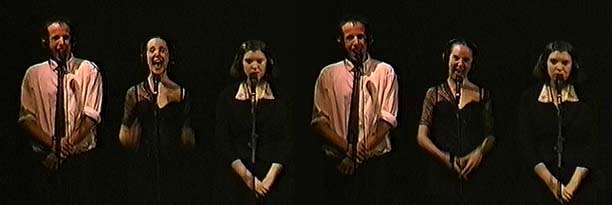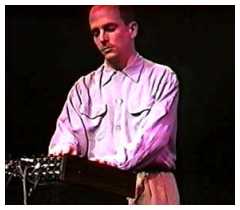
 |
![]()

![]()

Fried has brought many associations to bear. Connections can be found in experimental text works: Joyce, e. e. cummings, Berio's Sequenza III for solo voice, Babbitt's Philomel, the Fluxus group and the Theatre of the Absurd, the work of several vocalists: Shelley Hersh, Joan La Barbara, Carles Santos, perhaps traces of Meredith Monk. You are reminded of watching an opera in a language you don't know. But there is a level of external tension here foreign to the work of these other artists, except perhaps for Santos at his best. In Headset Sextet the performers' focus seems to be coming out of almost perverse concentration mitigated by fear. The edge produced is palpable: the stage is charged. The vocalists are constantly skirting complete disaster, but so involved and so forward propelled that the fear is vanquished as they continually move on to the next perilous phrase.

Fried has accomplished his mass of swirling vocals and electronica amid impassioned
force and fear by way of a cleverly articulated plan. The performers are delegated an
impossible task and then required to repeat this task for the duration of the work.
Each headset conveys the exact text - in English -
that each vocalist is to perform. All phrases, articulations and dynamics are to be
imitated as closely as possible. However, the vocalists have never heard the tape
prior to the performance.
 Fried requires the vocalists to reproduce
the exact sounds, texts, pitches, timbres they hear - simultaneously.
This is obviously impossible, as the vocalists are required to say words exactly as
they hear them, with no delay. They are forced to predict what syllables and words
they will hear, but the concentration to keep up, to not get lost, means that they
articulate only as much as is possible. They can't do it, but they convincingly
attempt it, failing through the entire. A subtle language of non-language is
produced. Phrases and cadences have a ring of authenticity but no meaning, beyond
the remnants of the qualitative tone of the original, to which is added the anxiety,
the performance capacity and yes, virtuosity of the continually scrambling, induced
error-making vocalists. This is not music for perfectionist performers. They must be
willing to submit to continual error, to let their errors pass through them without
cynicism, with the knowledge and belief that what they are doing is the completely
correct response. Their artistic expression exists in error well-made and the
unfathomable faith required to continue with the constant impossibility of their task.
Fried requires the vocalists to reproduce
the exact sounds, texts, pitches, timbres they hear - simultaneously.
This is obviously impossible, as the vocalists are required to say words exactly as
they hear them, with no delay. They are forced to predict what syllables and words
they will hear, but the concentration to keep up, to not get lost, means that they
articulate only as much as is possible. They can't do it, but they convincingly
attempt it, failing through the entire. A subtle language of non-language is
produced. Phrases and cadences have a ring of authenticity but no meaning, beyond
the remnants of the qualitative tone of the original, to which is added the anxiety,
the performance capacity and yes, virtuosity of the continually scrambling, induced
error-making vocalists. This is not music for perfectionist performers. They must be
willing to submit to continual error, to let their errors pass through them without
cynicism, with the knowledge and belief that what they are doing is the completely
correct response. Their artistic expression exists in error well-made and the
unfathomable faith required to continue with the constant impossibility of their task.
 The technology is relatively simple in this work, unlike some of Fried's other works which
involve programming enviroments. An MDM (modular digital multi-tracker), in this case
an ADAT eight-track recorder plays back six vocal tracks and two tracks of electronica.
The six tracks are dedicated one each to the six performers. The stereo electronic
tracks play live to the house. The headsets route the vocal tracks to be imitated to
each vocalist. The pre-constructed vocal tracks contain highly dramatic spoken word
texts, including movie clips and some singing. The group has rehearsed the technique
on 'practice' tracks which are similar to the 'performance' tracks. Once the vocalists
have performed the work they can never perform it again as they would lose their
completely spontaneous reaction to the text.
The technology is relatively simple in this work, unlike some of Fried's other works which
involve programming enviroments. An MDM (modular digital multi-tracker), in this case
an ADAT eight-track recorder plays back six vocal tracks and two tracks of electronica.
The six tracks are dedicated one each to the six performers. The stereo electronic
tracks play live to the house. The headsets route the vocal tracks to be imitated to
each vocalist. The pre-constructed vocal tracks contain highly dramatic spoken word
texts, including movie clips and some singing. The group has rehearsed the technique
on 'practice' tracks which are similar to the 'performance' tracks. Once the vocalists
have performed the work they can never perform it again as they would lose their
completely spontaneous reaction to the text.
Copyright © 12 February 2000 Jeff Talman, Saratoga Springs, NY, USA
![]()